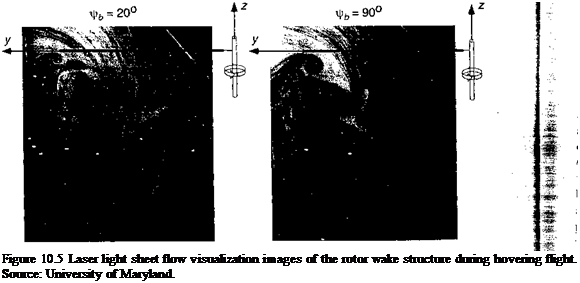. Characteristics of the Rotor Wake in Hover
10.3.1 General Features
In hovering flight a helicopter rotor wake is radially axisymmetric (at least in principle) and somewhat easier to study by means of flow visualization because only one view at successive blade positions (azimuth angles) is necessary to obtain a complete 3-D understanding of the wake topology. Figure 10.5 shows representative flow visualization images in the wake of a two-bladed rotor operating in hover. In this case, a fine mist of submicron atomized oil particles was illuminated with a thin laser light sheet that was positioned in a radial plane extending through the rotational axis of the rotor. The sheet was pulsed at a frequency of one flash per rotor revolution, so as to create an instantaneous illumination of the wake – see Martin et al. (1999) for further details. The results in Fig. 10.5 are for two blade azimuth positions.
 |
Notice the existence of two major flow features in Fig. 10.5. First, the blade tip vortex cores are identified by the dark seed voids. Wherever the local velocities are high enough to cause centrifugal forces on the seed particles, they will spiral radially outward. The particles will reach a radial equilibrium only when the centrifugal and pressure forces are in balance. The resulting voids can be larger than the actual viscous core size of the tip vortex – see Leishman (1996). Second, there is a shear layer trailed behind the blade, which is apparent in Fig. 10.5 by a discontinuity in the streaklines. This shear layer is formed by merging of the boundary layers from the upper and lower surfaces of the blade, which contain both negative and positive vorticity. This shear layer is often referred to as a vortex
|
|
|
Figure 10.6 Tip vortex displacements of one – and two-bladed rotors operating in hover. Cr/cr & 0.1. Data source: Leishman (1998) and the University. of Maryland. |
![]()
![]() sheet.2 The sheet has a strength that is related to the spanwise gradient of lift (circulation) over the blade. Initially, the vortex sheet is seen to extend over the entire blade span. Thereafter, both the sheet and the tip vortex are convected below the rotor disk. The significant inward (radial) contraction of the tip vortices below the rotor is clearly evident. Both the tip vortex and the inner sheet are typically found to be visible for about two rotor revolutions, after which details of the individual flow structures become harder to discern. This is because of diffusion of the seed particles, as well as because the wake further downstream becomes aperiodic as it ultimately transitions into a turbulent jet.
sheet.2 The sheet has a strength that is related to the spanwise gradient of lift (circulation) over the blade. Initially, the vortex sheet is seen to extend over the entire blade span. Thereafter, both the sheet and the tip vortex are convected below the rotor disk. The significant inward (radial) contraction of the tip vortices below the rotor is clearly evident. Both the tip vortex and the inner sheet are typically found to be visible for about two rotor revolutions, after which details of the individual flow structures become harder to discern. This is because of diffusion of the seed particles, as well as because the wake further downstream becomes aperiodic as it ultimately transitions into a turbulent jet.












